Islamic World: Last 100 Years
 y the middle of the 19th century (1850), decline of Islamic empires was truly and completely real.
y the middle of the 19th century (1850), decline of Islamic empires was truly and completely real.
Empires Of Islam
After a 1000 years of expansion and dominance, by 1850 just two declining Islamic powers were left to compete on the world’s imperial stage. One was the Mughal Empire that controlled India. An India, that was: –
- The world’s largest economy
- World’s largest industrial producer
- Biggest gunpowder manufactory
- With the largest gold reserves
- Enviable with shipbuilding capacity and technology
- A steel industry whose output was in demand the world over.
The other major Islamic Empire was the Ottoman Empire, centered in modern Turkey, that controlled a geography from the borders of Iran to the outskirts of Europe.
From Western Seas
Opposing these Islamic Empires were the Christian colonial Empires of Spain & Portugal, France and Britain.
The first challenge to the Christian colonial Empires came from India – with the Anglo-Indian War of 1857.
Stretching over a period of nearly two years, the alliance was nominally headed by the Mughal Emperor, and the war was mainly between the Marathas and a mercenary army of Indian soldiers, raised and equipped by the British. The war-chests of Maratha-Mughal alliance were puny compared to the British capital – bolstered by huge capital inflows from slave trade, slave plantations of sugar and tobacco, apart from piracy, loot and plunder.
Within two years, the Mughal Empire was over.
Minor Islamic kingdoms of Egypt and Persia ruled at British sufferance. The Ottoman Empire folded up 60 years later.
In 1920.
Under Western Thumbs
Nearly a 100-years after the end of the Ottoman Empire, the Islamic world is still ruled by Western puppets.
In Pakistan, Saudi Arabia, Iraq, Libya, Afghanistan, Egypt – or a Turkey which is happy being at the periphery of every Western alliance – CENTO, European Union, etc.
Under Nasser or Yasser Arafat, people mobilization was a political movement – the agenda being independence from Western subjugation.
All these movements succumbed to religious obscurantism after the overthrow of Shah Of Iran. Iran’s incendiary mix of religion and anti-American politics found a Sunni resonance in Saudi Arabia with a Wahhabi revival. Pakistan turned from Deobandi to Wahhabi strains of Islam.
Desperate situations call for desperate …
The use of fundamentalist Islam has been successful in increasing citizen enlistment against the West. Apart from the solitary success of increasing enlistment, the Shia-Sunni consensus on fundamentalism has delivered nothing on political governance, economic growth, social justice, modernization of education or even military preparedness. This uni-dimensional agenda of ‘modern’ Islam has many detractors within and outside the Islamic world.
In the last 40-odd years
Recently released classified information and memoirs by retired spies, provide a more complex picture of the CIA, its effectiveness, and its overall power, suggesting that at times Langley was manned not by James Bond clones but by a bunch of keystone cops. My favorite clandestine CIA operation, recounted in Tim Weiner’s Legacy of Ashes, involves its 1994 surveillance of the newly appointed American ambassador to Guatemala, Marilyn McAfee. When the agency bugged her bedroom, it picked up sounds that led agents to conclude that the ambassador was having a lesbian love affair with her secretary. Actually, she was petting her two-year-old black standard poodle.
But the CIA’s history does include efforts to oust unfriendly regimes, to assassinate foreign leaders who didn’t believe that what was good for Washington and Wall Street was good for their people, and to sponsor coups and revolutions. Sometimes the agency succeeded.
Topping the list of those successes—if success is the right word for an operation whose long-term effects were so disastrous—was the August 1953 overthrow of Iran’s elected leader and the installment of the unpopular and authoritarian Shah in his place. Operation Ajax, as it was known, deserves that old cliché: If it didn’t really happen, you’d think that it was a plot imagined by a Hollywood scriptwriter peddling anti-American conspiracies.
Ervand Abrahamian isn’t a Hollywood scriptwriter but a renowned Iranian-American scholar who teaches history at the City University of New York. With The Coup, he has authored a concise yet detailed and somewhat provocative history of the 1953 regime change, which the CIA conducted with the British MI6. If you don’t know anything about the story, The Coup is a good place to start. If you’ve already read a lot about Ajax and the events that led to it, the book still offers new insights into this history-shattering event.
Abrahamian constructed his narrative by analyzing documents in the archives of British Petroleum, the British Foreign Office, and the State Department as well as the memoirs of the main characters in the drama. These characters—British spies and business executives, American diplomats and journalists, Soviet agents, Communist activists, Nazi propagandists, Shiite mullahs, Iranian crime bosses—have double or even triple agendas to advance as they jump from one political bed to another and back, lying, cheating, stealing, and killing. It all makes the CIA-led extraction of the American hostages in Iran, depicted in the film Argo, look kind of, well, boring.
On one side there was Muhammad Mossadeq, the democratically elected prime minister of Iran from 1951 to 1953, a secular, liberal, and nationalist leader who wanted to join the “neutralist” camp that disavowed commitment to either of the superpowers during the Cold War. An aristocratic and eccentric figure who welcomed foreign officials into his house wearing pajamas, Mossadeq introduced many progressive social and economic reforms into the traditionally Shiite society, and sent shock waves across the world when he moved to nationalize Iran’s oil industry, which had been under British control since 1913 through the Anglo-Persian Oil Company.
On the other side there was Kermit “Kim” Roosevelt, Jr., Teddy’s grandson, a legendary spymaster, a self-promoter who dined with major world leaders and business executives but also befriended power-hungry Iranian military generals, corrupt politicians, merchants in the bazzar, and quite a few thugs, who helped him achieve what became Washington’s goal: to remove Mossadeq and his political allies, which included liberals, social democrats, and Communists, from power; to return the oil industry into British hands (with more American presence in Iran’s oil business); and to place reliable pro-western politicians in power.
It seemed to work beautifully. The United States gained a key strategic ally in the Middle East. American companies received a considerable share of Iran’s enormous oil wealth. Other oil-producing Middle Eastern nations got a lesson in what might happen if they nationalized. At a time when the Americans were facing challenges from nationalists such as Egypt’s Gamal Abdel Nasser and were trying to contain the so-called Soviet threat in the Middle East, Our Man in Tehran welcomed American soldiers and investors (and purchased a lot of American weapons). It all looked good until it didn’t.
While the coup did set back the nationalization of the oil resources in the Middle East, the delay ended in the 1970s. In that decade, Abrahamian writes, one country after another—not just radical states such as Libya, Iraq, and Algeria, but conservative monarchies such as Kuwait and Saudi Arabia—“took over their oil resources, and, having learned from the past, took precautions to make sure that their oil companies would not return victorious.”
At the same time, the coup decimated the secular opposition, leaving Shiite clerics as the most viable political force when the Iranian Revolution deposed the Shah in 1979. The pro-American puppet gave way to a radical and anti-American Islamic Republic where the secular and liberal opposition remains weak and leaderless. That, as they say in Langley, is blowback.
The coup also intensified what Abrahamian calls the “intense paranoid style prevalent throughout Iranian politics.” While the Iranian clerics worry that Washington wants to do a rerun of the 1953 regime change, many members of the opposition are counting on that to happen. In Tehran, they still think the CIA makes the world turn around.
Related Articles
- New Light on the CIA Coup in Iran on its 60th Anniversary: Why “Argo” Needs a Prequel (Sternfeld) (juancole.com)
- Robert Scheer: Oscar 2013: Hollywood’s CIA Celebration (huffingtonpost.com)
- Putting the Iran “Threat” in Perspective (counterpunch.org)
- Even if Iran gets the Bomb, it won’t be worth going to war (telegraph.co.uk)
India’s Future: Not leaders! Not Institutions! Then How Will India’s Future Emerge?

In a short thirty years, the greatest empire in world history had been humbled. In less than 70 years, they are back.
|
The boycott of Simon Commission by Indian negotiators sounded the death knell of the British Raj in India. (Cartoonist – David Low (1891-1963) Published – Evening Standard, 11 Feb 1928). Click for larger image.
Rock & A Hard Place
Between 1916, when Lokmanya BG Tilak, declared ‘Swaraj is my birthright’ to Atlee’s announcement of British withdrawal, in February 1946, in a short thirty years, the greatest empire in world history had been humbled.
In less than 70 years, they are back.
While we discuss, argue, shout, scream, talk, negotiate
Anglo-American forces today control Af-Pak region. The Indian Government and the people of India see Pakistan, an Anglo-American agent, as its prime rival – instead of the Anglo-American patrons as the root cause.
In the last 20 years, India has lowered guard considerably – and unless, this direction is reversed swiftly, the Indian Nation maybe in peril.
In the last 12 years
It has become common in Indian media to promote colonial ‘contribution’ in the building of modern India.
With memory dim, for India’s Y2K generation, Indian poverty after colonialism, the food and clothing shortages are only stories. The context forgotten, India’s Y2K generation is being shoe-horned into blindness, by a shouting brigade.
Led by the ‘intellectuals’ like ‘Lord’ Meghnad Desai, Amartya Sen, or Indian origin journalists with global-Western media like Sadanand Dhume, or hoax journalism like Andy Mukherjee or lazy writers in the mould of Krittivas Mukherjee, aided by Indo-Western academics like Jagdish Bhagwati, Rafiq Zakaria, etc.
Within India itself, this shouting brigade has a large following, too many to name or count.
To illustrate this point,
India has a constitution; Pakistan has editions. These are the various Pakistani constitutions: 1935 (secular), 1956 (federal), 1962 (dictatorial), 1973 (parliamentary), 1979 (Islamic), 1999 (presidential), 2008 (parliamentary). Why do they keep changing and searching? Muslims keep trying to hammer in Islamic bits into a set of laws that is actually quite complete. This is the Government of India Act of 1935, gifted to us by the British. (via What ails Kashmir? The Sunni idea of ‘azadi’ – Columns – livemint.com).
Birth of a Nation
To this school of commentariat, Indian Constituent Assembly counts for nothing.
The Constituent Assembly, which included at least 50% of the Indian political leadership and their work over 25,000 man-hours, amount to nothing. Or the Indian contribution to the making of the Government of India Act of 1935, itself.
In a short period of less than 30 months, India wrote and implemented its constitution. It has been been a rather pliable constitution getting amended a number of times – and yet has been upheld and respected by all the extensions of the State. Britain enacted The Government of India Act, first in 1919 and then in 1935. Some Indians have claimed the Indian Constitution is nothing original – but based on The Government of India Act, 1935, by the British Raj.
The wonder is not any document. It is in making it work.
What matters to Indians are not declarations of belief – but hard, real actions. In the words of Sarvepalli Radhakrishnan, ‘what counts is conduct, not belief’. American declaration of independence talked of ‘all men are created equal’ and promptly became the biggest importer of slaves in the history of the world.
For how long will our glitterati, chatterati, papparazzi, intelligentsia, cognoscenti, continue with this bilge.
Just the two of us!
At this stage it maybe worthwhile to revisit the record of Republican Democracy.
In the last 250 years, just 6 countries succeeded with Republican democracy without a significant breakdown in the first 50 years. Of the six, Sri Lanka (pop. 200 lakhs) Switzerland (pop. 80 lakhs), Israel (pop. 75 lakhs) and Singapore (pop. 50 lakhs) are tiny countries to generate any valuable data, models, norms or precedents. In any other day, age and society, the republican-democracy model would have been laughed off – and not studied by millions.
America became one of the first successful republican democracies – from 1789, when George Washington became the first elected President of USA. 70 years later, the strains were showing – North versus South. America was on the verge of Civil War – the main cause of which was the desire of the Southern states to remain independent (due to tariff issues) or at best as a loose confederation – not a federal union (actually slavery was a side issue).
The reason why India’s Republican Democracy works is because Indian genius has made it work. It is the commitment to make the system work, which is why the system is working.
Though some may cavil about how well (?) it works!
Meeting of minds
In the period between 1916 to 1946, India developed a national consensus and agenda.
On many subjects there was no political or even popular leadership. For instance, in 1944, Indian businessmen, in the middle of WWII, met and started work on an industrial policy for independent India. Or the huge protests by the entire Indian nation against the Red Fort Trials of the INA.
Of greater significance was the meeting that Gandhiji called in November 1947. This meeting was to happen in February of 1948. On January 30th, 1948, Gandhiji was assassinated. But Gandhiji’s co-workers went ahead and organized the meeting at Sevagram, Wardha, between March 11-March 14 1948 (alternate date (PDF) is March 13-15, 1948).
Gandhi is Gone: Who Will Guide Us Now? edited by Gopalkrishna Gandhi. (is a) remarkable book (that) is a record of introspection amongst Jawaharlal Nehru, Dr Rajendra Prasad, Maulana Abul Kalam Azad, Vinoba Bhave, J B Kripalani, Jayaprakash Narayan and others, at Sevagram in March 1948.
They had been charged by the Mahatma to consider the type of institutions India would need for its development and what should be the role and structure of the Congress party. Nations are ill-served when their institutions fail to evolve to fit their needs. The questions the Mahatma had posed in 1948 have become burning issues again.
Much was discussed – and powerful figures like Vinoba Bhave and Jayaprakash Narayen decided to work from within and and outside the system. With no constitution, without a Parliament, without elections, India was being governed by a British administrator, at Indian request, to provide continuum, from the Raj to a sovereign India. From these discussions was born the Vinoba Bhave’s Bhoodan movement – and Jaya Prakash Narayen’s Sarvodaya movement.
Without the power of the State, these movements worked on the power of suasion – and were powerful movements till the Bombay High generation took over the country, in 1975.
Unlike Pakistan
This ‘gift of the British’ to us Indians is a public document.
If it’s value is so apparent, why have others not been able to take advantage of it. The same British, gave the same document to the Pakistan also. So, this claim that Indian Constitution, Indian democracy, even the British nation are a British ‘gift, is not only incorrect and illogical. Immaterial too!
This a claim not even worth examining, since this Government of India Act, 1935, has been in public domain for more than 75 years. Pakistan had all the rights to it. Apart from India – and to how many other colonies in the world, I have never counted..
Why could Pakistan do nothing with it.
In fact Pakistan’s Constituent Assembly dragged this Constitution-making exercise till October 1956.
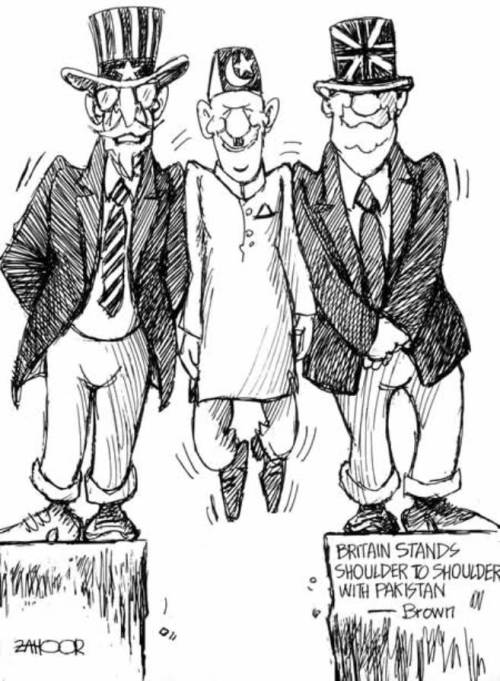
Is Pakistan A Free State? Cartoon by Zahoor in Daily Times, Pakistan | Click for image.
Cut back to 1956 Pakistan
Remember that 1956 was the year of India’s 2nd general election.
Also the year when Pakistan became a republic – and the first constitution of Pakistan was adopted.
Governor General Sahibzada Sayyid Iskander Ali Mirza (a Shia Muslim from Bengal, direct descendant of Mir Jaffer) became the first President of the Pakistani Republic.
Two years later, in October 1958, President Iskander Mirza staged a coup d’état and dismissed the constitution. Shortly afterwards General Ayub Khan deposed Iskandar and declared himself president. These shenanigans started the tradition of Army rule in Pakistan.
To an emerging Pakistan, after a 9 year struggle to write a constitution, two years later, the Army declared that the Constitution was worthless piece of paper. Another Constitution was written in 1962, and then a third.
And a few more after that.
British Governance
For a realistic assessment of the British ‘capability’ to govern, let us look at British misrule in Britain itself.
How could super-power Britain spiral down to bankruptcy, in less than 70 years, after WWII. If their ideas of governance and administration were so good, why could they not save themselves from this slide in fortunes? British ‘capabilities’ in areas of technology, industrial management, academia stands naked and exposed.
It is the British mindset itself that may need examination to understand this decline!
British Loss of Power
1916 – April 16. BG Tilak declares Swaraj is my birthright; forms Home Rule League at the Bombay Provincial Conference held at Belgaum.
1927 – Indian polity refuses to negotiate with Simon Commission.
1930 – Bhagat Singh displays disinterest in the legal outcome of his trial.
1944 – India’s leading industrialists come together (Bombay Club) and make an economic-plan document for an India which was yet to be born; for a government that was yet to be formed.
1946 – Naval Ratings raise the Indian Flag of independence.
1947 – Britain out of India
Managing the Indian State
The Indian State today, like its Desert Bloc’s cousins, is getting entangled in my marriage, in my sex life, in my monetary affairs, in my disputes with my neighbors, in my housing layout, in my sewage, in my garbage.
Why? Get out of my life.
Instead, we the people must set a clear agenda for the government. And the Top-3 items on are
- defence
- Defence
- DEFENCE
Related Articles
- Why Pakistan Never Became Democratic (quicktake.wordpress.com)
- Ershad’s Visit To India Whets His Political Ambition – Analysis (eurasiareview.com)
- Bangladesh: A Step Behind Pakistan or a Step Behind India (quicktake.wordpress.com)
- A first: US allowed to check Indian warship (quicktake.wordpress.com)
- Koenraad Elst: Singing Bhajans to British Gods to an Indian Audience or The Game Is Over (2ndlook.wordpress.com)
- India & Socialism – Nehruvian Folly? (hidf1.wordpress.com)
- NYT Takes CIA Pre-Clearance Before Criticizing POTUS (quicktake.wordpress.com)
- In Yumm-Rika There is no Corruption or How IAC Completely Gets The Story Wrong! (quicktake.wordpress.com)
- So you think it wont happen to you? It just did … (quicktake.wordpress.com)
- Valmiki, Orwell & Twitter – The Missing Link (quicktake.wordpress.com)
Why Schools, Hospitals, Political Parties don’t work in India. At least upto user expectations

If the Government has to declare that the Parliament is supreme, maybe the Parliament is no longer supreme. Is there a rumble gathering in Indian polity?
|
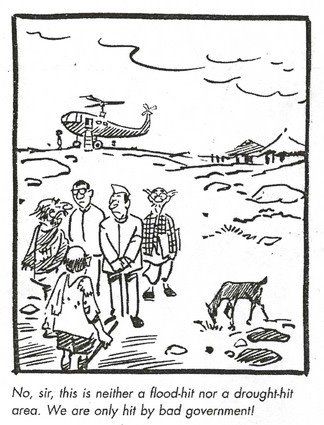
Clearly, the Indian has been less than a success in some fields. Notably health, education and producing venerable leaders. | A undated, unsigned RK Laxman cartoon.
India – Failed State?
In the last sixty-five years of Indian independence, India has seen many successes – and had its share of failures, too.
Modern India is tempted to romanticize or demonize the Western and Islāmic influences and legacies – depending on the personal bias and predilection. This bias is not only popular but also widely prevalent in academia and the media.
Of the significant Indian failures has been healthcare, education and the Indian Politician. While many imports into India have been successful – like democratic elections, smooth handover of power after elections, public-sector enterprises, the software and automotive industry, there are three institutions that India has not been able to make a success of.
- Health-care through hospitals
- Education through schools
- Venerable polity through political parties
Building an agenda
Yogendra Yadav, who is part of the 7-member panel that will guide the formation of Team Anna‘s political unit, makes some interesting points.
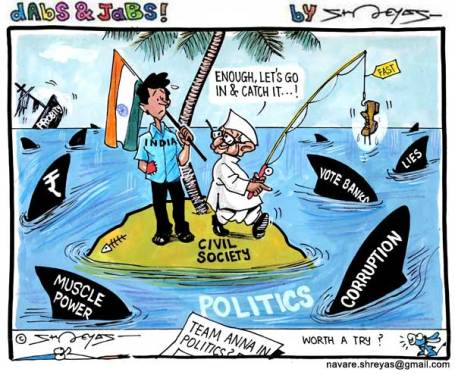
Will Party-Anna be significantly different. BJP had promised, falsely, that they will be different. | Cartoon by Shreyas Navare on Friday, August 3, 2012 at 8:35 pm in blogs.hindustantimes.com
Many of the Anna followers have had obvious difficulty in reconciling the strident anti-party rhetoric of the movement with its latest decision. Some have seen it as a betrayal. But if we step back from the specific context of the current discussion, both these assertions may not appear so incompatible with each other. There is no doubt a tension here, but this tension is necessary and perhaps even creative.
The dilemma of Team Anna provides a good lens to view our troubled relationship with the institution of the political party in the last 65 years. Political parties are both very robust and fragile, at once the magnet that draws people and pushes them away, ever-present and routinely hated. Hence the widespread ambivalence towards this institution. After all, founders and leaders of very different parties, such as Gandhi and M N Roy, ended up advocating party-less democracy. And it was Jayaprakash Narayan, an advocate of party-less democracy, who later formed the Janata Party.
The idea of the political party, an imported form of political organisation, has captured modern Indian political imagination. The institution of the party has acquired the same status in our political imagination as the institution of school in thinking about education or the institution of the hospital in thinking about disease and healing. The word ‘party’ is now used in almost every Indian language to refer not just to modern political parties that contest elections but also for any political grouping or faction in a local context. It is not uncommon to hear complains about ‘partybaji’, meaning groupism or factionalism, in a village.
This success is not confined to ideas and language. Very few other institutions can match political parties in the width and depth of their reach in this large and diverse country. Contrary to popular impression, fragmentation and proliferation of parties has actually contributed to deepening of their reach. The rise of regional and caste- or community- based parties has brought parties closer to the people. Between 1971 and 2004, the proportion of voting-age Indians who identified with a political party went up from 38% to 51%. During the same period, those who claimed to be a member of a political party went up three times, from 5% to about 15%.
In other words, the poli-tical party as an organisational format is here to stay. It has outlived proponents of party-less democracy and outpaced non-party political formations.
At the same time, the prevalent form of the political party does not enjoy much popular legitimacy. Even those who identify with a political party express an abstract disaffection with the nature and functioning of political parties in the country. Parties are held to be at the roots of all the problems in the country.
Some of the ills of the parties are nearly universal. Instead of being institutions that represent the peoples’ aspirations and demands, political parties have become election machines and patronage distribution networks that focus only on gathering votes by using all kinds of short cuts. While they talk about democracy and competition, most political parties in India lack even a modicum of internal democracy.
In our context political parties have acquired some special difficulties. The model of a centralised party does not easily fit with the scale and diversity of a county like India. As centralised ‘high command’ driven parties seek to reserve power for a coterie of leaders, if not a family, people do not experience parties as an entity that derives power from them. Greater number of parties does not necessarily mean greater political choice as different parties are effectively tied to the same policy. Party politics is not a nice word.
Having taken root in an alien soil, this tree has acquired a new shape. Its fruit tastes different from that of its counterpart in other parts of the world. Everyone consumes it, but few seem to like its taste.
This is the lesson Team Anna can learn from the experience of political parties since Independence. The political party is both inevitable and avoidable. While there is a need for a vehicle of political opinions and interests that seeks to direct state power, it is equally important that this vehicle be designed differently.
The new vehicle must not be focussed only on elections: struggle, constructive work and formation of ideas must be equally critical to a new kind of party. Instead of being the instrument of centralised power, it needs to recognise different levels of power at the regional and local levels. Instead of monopolising power, it needs to share power with other organisations and movements. It needs to build in norms of internal democracy. In other words it needs to build a political party that does not look or act like a political party.
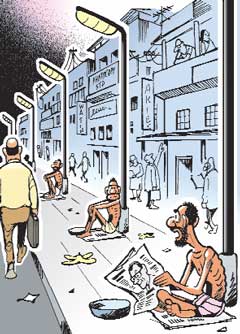
Connecting with the media is illusory power. Connecting with this man will make the difference. | Ajit Nina cartoon posted on Monday, June 08, 2009 at 03:35:27 AM in Mumbai Mirror captioned, ‘The idea of ‘one-man-one-post’ was stolen by the Congress from us.’
Just no practice
Probably the one reason the Indian State has failed on health, education and political factionalism is tradition. The Indian State, governed by the traditional norms of भारत-तंत्र Bharattantra did not manage healthcare, education and factional politics.
European and Islāmic records are significantly silent on variations in legal systems and State policies. The only point of difference that British writers mention is the predisposition of the rulers towards various European factions and on the differences in social customs.
Standardization – without centralization
While there is a large body of European writing on the different social units, norms, groups, practices, there is little mention about the differences in polity. This points to a great degree of standardization in polity – yet, without a central authority. On most political issues there was national consensus, even though political control over the Indian geography was spread thinly among 1000 rulers.
This precedent goes right back to the Indus Valley-Saraswati Basin cities which were widely spread, highly standardized – yet there was no central authority.
This may seem strange, because according to our failed education system, the British Raj made the Indian nation. But the part that modern studies miss out completely, is how in भारत-तंत्र Bharattantra, Indian kings did not make laws. Indians kings could not even proclaim a different legal system for their ‘own’ kingdom. Their powers were severely proscribed.
So how did the extensive legal system of भारत-तंत्र Bharattantra that the Islāmic kings perverted, British Raj dehumanized, and modern India has forgotten, come into being.
Two men are what made the law
Much of modern Hindu Law, is based on the two major legal systems that existed in India at the start of the British Raj. This was the Vighneshwara’s Mitākṣarā and the Dāyabhāga system. Dāyabhāga based mainly on the Yajnavalkya-smrti, was updated by Jimutavahana sometime between the eleventh or thirteenth century. Widely used in Bengal, Odisha, Assam and North East, modern Bangladesh, Bihar, Nepal, it has significant overlap with the Mitākṣarā.
Mitākṣarā, criticized in Jimutvahana’s Dāyabhāga system, preceded the Dāyabhāga system. Also based on Yajnavalkya-smrti, Mitākṣarā is considered more classical – and Dāyabhāga as more synthetic. This is not to imply that Mitākṣarā and Dāyabhāga were the start of the Indian legal system. Both Mitākṣarā and Dāyabhāga, were based on Yajnavalkya-smrti – which itself is derived from Manusmriti. Vishnu-purana states that there were different ‘manus‘ for different eras.
So which Manu from which era wrote the Manusmriti is unclear – though it is usually believed that Vaivaswata Manu is the author.
Not that it helps.
Advent of Islāmic rule in India
Interestingly, both Mitākṣarā and Dāyabhāga texts are dated roughly around the time that initial Islamic rule began in India with the Slave Dynasty in Delhi – at the beginning of 13th century.
Were Vighneshwara and Jimutvahana major court figures – like Raja Todar Mal, whose writings on Indian Law helped Mughals to steer their way around the legal environment in India. Hardly anything is known about the individuals, except the extensive work that they left.
So, how did these anonymous, powerless Brahmins become law-makers – without armies, parliaments, courts, judges and lawyers. At least comparable to the Islāmic and European contemporaries.
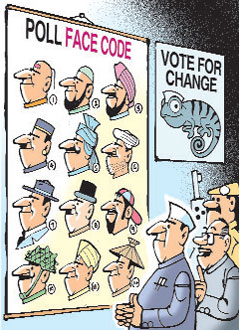
Bombay-High & Y2K generations has not produced venerable political leadership. Instead we have a collusive democratic leadership, which conspires against us. Divide and rule continues. | Ajit Ninan caroon with a caption that reads ‘Today it’s a make-up artist who gets you votes, not your speech writer.’; posted on Friday, February 17, 2012 at 02:17:47 AM; source & courtesy – Mumbai Mirror
Parliament is Supreme
While there is thin evidence that these Brahmins did have royal patrons, their legal standing did not depend on that patronage. More importantly, how did their writings cross the boundaries of the resident-kingdoms. From areas, where their patrons had power to areas where these two Brahmins had no influence, power or patronage?
State-controlled and managed models of the West, are relatively new to India. In the entire Anna-Baba campaign, the Indian Parliament kept repeating The Parliament Is Supreme. Did these repeated statements imply doubts about the supremacy of the Parliament?
Will the Anna-Baba political movement see re-birth of non-parliamentary legal systems?
Is that the flow – and the direction?
Anna-Baba are Opposites
This is in contradiction to the Anna campaign that has focussed on More State. Baba Ramdev’s campaign speeches have been largely based on a Lesser State. Can this basic disagreement be bridged?
Can Anna-Baba come together?
Team Anna’s campaign made much about the fact that some of them were Magsaysay award winners – while Baba’s campaign is more rooted in the Indian political tradition – भारत-तंत्र Bharattantra.
Team Anna has usually got excellent media support – and allegedly ‘foreign support. In case of Baba Ramdev, the commercial success of his Ramdev products points toward a deeper connect to the Indian Voter. Baba Ramdev has been building his campaign for nearly ten years now – while Anna campaign has sputtered for little over 10 months.
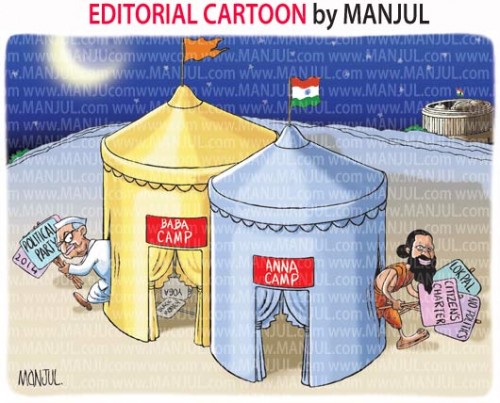
Anna-Baba may seem like peas in a pod. But they are vastly different by the way of agenda, policies, inpiration. | Cartoon titled Anna Hazare Vs Baba Ramdev by MANJUL on 8.12.2012.
Anna’s campaign was able to make Indian polity sit up – and take note. Baba Ramdev has been largely ignored by India’s political leadership – and the media. While Anna’s campaign has been over-analyzed to death, the Baba-Ramdev-phenomenon has been buried under silence by the media.
While the Anna-campaign for all appearances is a single-point campaign, Baba Ramdev’s campaign has been across a broad front – with much work on building a unique agenda.
Many have claimed credit for Anna-campaign’s success, starting with the media and RSS having the last word. In case of Baba Ramdev, his movement has been based on his own work and agenda.
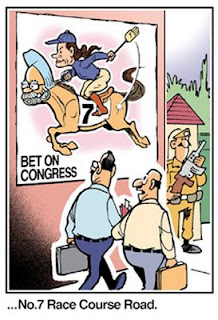
Electoral politics on the cusp of a major change? | Cartoon By Ajit Ninan (Times Of India) on March 26, 2009
Gimme, Gimme
How will the Indian Voter manage this divergence?
Will it give power to Anna-campaign – and make Baba Ramdev powerful enough to question the polity?
Early days …
Related Articles
- Bangladesh: A Step Behind Pakistan or a Step Behind India (quicktake.wordpress.com)
- Valmiki, Orwell & Twitter – The Missing Link (quicktake.wordpress.com)
- In Yumm-Rika There is no Corruption or How IAC Completely Gets The Story Wrong! (quicktake.wordpress.com)
- Global Health Threats: How Governments are Creating Them (2ndlook.wordpress.com)
- Malicious campaign on to divide Anna, team: Kejriwal (thehindu.com)
- Anna is not meant for forming a political party: Hegde (thehindu.com)
- Anna supporters unhappy, burn his posters (ibnlive.in.com)
- India Ink: Corruption’s Reach in India Spawns New Political Party (india.blogs.nytimes.com)
Why Do We Love Our Invaders So Much?

Colonial history produces in the minds of many English-speaking Indians, the belief that India has been a rather frequent military loser – even though facts are otherwise.
|
Colonial history, left largely untouched after Indian Independence, produces it own kinds of stunted minds. A 2ndlook reader responded with a revealing comment.
being a Hindu from east India (Bengal – Assam), believe me I would Any Day prefer the british or east India company, rather than live under nawab’s, muslim league, tikka khans (u know who was tikka khan, maybe you don’t know about the pakistan genocide of east bengali hindus in 70-71).
Ever head of the begali hindu renassiance in the 18-19 centuries (or for that matter the general Hindu reniasance all over india). I am sure u’ll be upset / angry / bitter to learn that it started once the british has booted out the nawbs / mughals
Koenraad Elst, recently wrote a blog-post calling Hindus cowards, questioning if they are all right in all the departments. All this because Hindus were not hounding out Muslims from India – or at least making them second-class citizens, if not putting them in concentration camps.
To make this point, Elst picked up on India’s partition (1947) into India and Pakistan (to later subdivide into Pakistan and Bangla Desh.).
Anglophiles apart, it is an accepted reading of events for the 1940-1947 period when the Partition was formalized, that the British did encourage Jinnah to make strident, aggressive claims for disproportionate authority and veto powers in the soon-to-be independent India – failing which, India must be partitioned.
Some 2ndlookers felt that Elst’s absolution given to the British, for the Partition of India was a trial balloon by vested interests. A logical doubt, as Koenraad Elst’s writing has been suspect – and his ‘scholarship’ distasteful.
It is Elst’s proposition in his post (linked above) – unsupported by any facts, links, citations, references that the British wanted a united India – but it was Muslims led by Jinnah who wanted otherwise.
Curiously, the most significant support for Elst came from some Indians. Some interesting ramifications and reactions to this debate.
Related Articles
Koenraad Elst: Singing Bhajans to British Gods to an Indian Audience or The Game Is Over

British were not the worst says Koenraad Elst. They killed some people. That is all. Just some fifty times more than Islamic raiders and invaders.
|
Koenraad Elst’s writing has been distasteful – and his ‘scholarship’ suspect.
A 2ndlook reader, Dr.OP Sudrania, drew my attention to a new post by Elst. Unlike 2ndlook, Elst does not respond to comments or criticism – probably, because he has none.
For reasons of time, I would not normally spend much time with verbiage of the Elst variety – excepting this was too easy.
Elst writes
Lord Louis Mountbatten, only accepted Partition because the Muslim League threatened and started violence.
via Koenraad Elst: The British were not guilty of Partition; somebody else was.
Is it beyond your Catholic-Christian intelligence to see how British could put Gandhiji behind bars for threatening non-violent protest! The British had no qualms (and artificial regret later) when O’Dyer opened fire on unarmed people in Jallianwala Bagh, Amritsar?
But could not do anything when Jinnah threatened and started violence? Your Christian-Catholic logic escapes my ‘Hindu-Indian’ thinking.
Completely.
Viceroys Lord Victor Linlithgow and Lord Archibald Wavell told Jinnah to his face that they would not countenance the division of their nice and neat Indian empire, not even in the event of decolonization. Their successor, Lord Louis Mountbatten, only accepted Partition because the Muslim League threatened and started violence.
via Koenraad Elst: The British were not guilty of Partition; somebody else was.
I presume it is below Elst’s Catholic-Christian intelligence to provide proof and citation of this. Day, date, time, place, witnesses, subjects discussed, duration of the meeting(s), other participants? Catholic Christian Elst gives no details.
Was Catholic Christian Elst the proverbial fly-on-the-British-wall, who witnessed these events first hand, in his previous birth?
brainwash the Indian Muslims into becoming India-loving Hindus
via Koenraad Elst: The British were not guilty of Partition; somebody else was.
I presume again that is is below Elst’s Catholic-Christian intelligence to provide data or source which shows that Indian-Muslims do not love India – as much as Hindus?
And what are ‘Hindus’ supposed to do? Send Indian Muslims to concentration camps?
Like America did with Americans of Japanese descent during WWII? Or Britain did to Boers during the Boer War? Or the Spanish did with Cubans in the War of Freedom by Cuban Slaves?
Or are we to follow the example of your king, Leopold of Belgium who managed to annihilate more than 1 crore people of Congo, who he deemed to be his ‘personal’ property?
British had nothing to do with Partition, and that this was a purely Muslim operation necessitated by the present democratic age’s belief in numbers.
via Koenraad Elst: The British were not guilty of Partition; somebody else was.
Is it below Elst’s Catholic-Christian intelligence to accept evidence from Jinnah’s statement when Jinnah said how “suddenly there was a change in the attitude towards me. I was treated on the same basis as Mr Gandhi. I was wonderstruck why all of a sudden I was promoted and given a place side by side with Mr Gandhi.”
I will argue that the British had nothing to do with Partition
via Koenraad Elst: The British were not guilty of Partition; somebody else was.
Mr.Elst, you will make your Catholic-Christian arguments without citations, evidence, links, quotes, sources, because the Hindu is polite to stop you?
It is only the fledgling Cold War that made the British and also the Americans see a silver lining in the Partition, viz. that one of the parties would join the Western camp and provide it an outpost to monitor the Soviet threat
via Koenraad Elst: The British were not guilty of Partition; somebody else was.
Is it beyond your Catholic-Christian intelligence to do some background study about the The Great Game that was played out between the Tsarist & Soviet Russia and the British from 1840-1940?
How Russia was seen as the biggest threat to the Indian Empire by the British Raj?
To be sure, the British were guilty of many things, and the fixation of Hindu nationalists on them is understandable. Principally, they caused several very serious famines, they dismantled the technology and economic structure of India, and they imposed a foreign ideology that harmed the natives’ self-respect. This did not make British rule “the biggest crime in history”, as L.K. Advani claims on his blog (15 July 2012), but it was pretty bad.
via Koenraad Elst: The British were not guilty of Partition; somebody else was.
After killing more than 25 million Indians – which is about 50 times more than what the Islamic invaders and rulers killed and enslaved, your Catholic-Christian intelligence believes that the British were not the worst killers in the history of humanity – way beyond Hitler.
I would agree with you on one thing here.
The Hindu is too polite – and should actually go after your Catholic-Christian *#@* with all that he has in all his god-given Hindu departments … and a crowbar, to prove his courage!
Hindus who blame the British for Partition, show that they are afraid of the truth, and afraid of Islam. It is far easier to accuse the British, who have safely departed, than to lay the blame at the door of Islam. Blaming Islam opens a can of worms, it is difficult to deal with this religion. It is a challenge to one’s courage, but it is mainly a challenge to one’s intelligence. If you are deficient in these departments, then go ahead and blame the British.
via Koenraad Elst: The British were not guilty of Partition; somebody else was.
Is there a deficiency in your Catholic-Christian departments that you should deal with facts, documents, sources, evidence, quotations – and not in hate, name calling?
Can a Catholic-Christian intelligence rise above it’s vile, genocidal ways of the last 2000 years?
It is here that I have more reason to worry. Though Hindus have shown great intelligence in the literature of the past and ICT initiatives of the present, they have mostly failed to apply their intelligence to the Islam problem, though this is staring them in the face every day. But I am confident that now you will do something about it.
via Koenraad Elst: The British were not guilty of Partition; somebody else was.
Your Catholic-Christian mind has a good reason to be worried. Indians are seeing through the Christian-Progressive-Liberal Game – and you may be out of business.
Faster than you imagine.
Related Articles
- British Raj: Expansion In India was Swift and Easy says British-American Historian (2ndlook.wordpress.com)
- Demonization: Method; Mechanics & the Madness (2ndlook.wordpress.com)
- How Jinnah was made Important; became Somebody & got Pakistan (2ndlook.wordpress.com)
- Bangladesh: A Step Behind Pakistan or a Step Behind India (quicktake.wordpress.com)
- Why Do We Love Our Invaders So Much? (2ndlook.wordpress.com)
- Mumbai Muslims Protest: Collusive Democracy At Its Best (quicktake.wordpress.com)


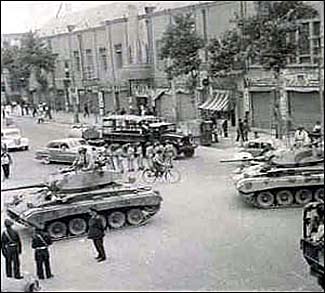
















15 comments